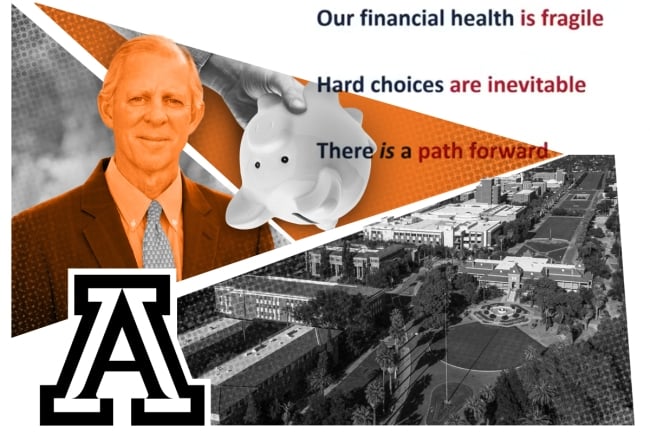You have /5 articles left.
Sign up for a free account or log in.

Deep cuts are expected at the University of Arizona after major financial miscalculations.
Photo illustration by Justin Morrison/Inside Higher Ed | Getty Images | Rawpixel | University of Arizona
The University of Arizona has just 97 days’ worth of cash on hand—significantly less than previously forecast, a recent Board of Regents meeting revealed. The news has prompted significant scrutiny and raised the specter of deep institutional cuts to restore stability to the university’s reserves.
Since the revelation at the Nov. 2 regents’ meeting, the faculty has criticized senior administrators for mismanagement, accusing them of losing track of more than $240 million through accounting errors and flawed financial projections.
Now UA officials have until Dec. 15 to submit a plan to the regents to restore cash-on-hand levels to the 120 days’ worth the board requires. Details of the plan remain unclear, and the process is fraught with faculty concerns over mismanagement and a lack of transparency. The crisis has also caught the attention of state officials, who have stressed a need for accountability.
The Revelation
In June, UA’s chief financial officer, Lisa Rulney, told regents the university had 156 days of cash on hand. But by November that estimate had fallen to 97 days.
“The last few months have exposed the depth of our financial vulnerabilities,” Rulney told the board at the Nov. 2 meeting, revealing the staggering financial discrepancy.
She attributed the decline partly to a flawed revenue-projection model, which exaggerated the amount of cash on hand by an estimated 30 percent. UA has since replaced the model.
“I want you to know that when I told you we were forecasting 156 days of cash on hand, I was not hiding the ball or trying to obfuscate a problem that we have at the University of Arizona,” Rulney said.
Rulney and UA president Robert Robbins also pointed to spending on strategic investments.
“We made a bet on spending money,” Robbins said. “We just overshot.”
Rulney noted strategic investments were focused on helping UA to reach the “fourth industrial revolution”—a reference to an increasingly technology-driven world—and “to increase our rankings.”
Robbins also cited the cost of providing merit- and need-based financial aid, the growth in research expenditures, and a $55 million loan to the athletics program, which has not been paid off.
“We had assumed when we used cash on hand to support athletics that there would be an increase in revenue, and it just turned out not to be the case,” Robbins told regents, adding that the loan has not been paid back “fast enough.”
Another factor, largely absent from the public discussion but noted in board documents, was the university’s purchase of the online, for-profit Ashford University in 2020. The deal, made in an effort to expand UA’s online offerings, led to the creation of the University of Arizona Global Campus. Though the purchase only cost $1, the deal has clearly added to UA’s financial woes.
“The acquisition of UAGC added $265.5M in operating costs, thus increasing the denominator in the days [on hand] cash formula,” reads part of an executive summary provided to the board.
(University officials did not respond to most questions sent by Inside Higher Ed but sent the following statement about Global Campus: “We will not have an operating loss in FY25 due to UAGC. UAGC is making one-time investments as part of its transition into the University of Arizona. UAGC brought $40 million in cash to fund these efforts while also realizing the amortization and depreciation.”)
Further complicating matters but not mentioned in the executive summary: the Department of Education is looking to recoup $72 million in discharged loans after it determined that Ashford defrauded students. It is unclear whether UA will be on the hook for those funds.
The executive summary also pointed to inflationary costs and “market pressures on salaries.”
With the problem now in plain sight, Rulney noted that hard choices lie ahead for the university. In both public remarks from the administration and documents provided to the board, officials indicated that potential solutions include implementing a hiring freeze and selling off assets. A four-year tuition guarantee and university financial aid are also on the chopping block; generous discounts for out-of-state students have undercut tuition revenues.
Faculty Concerns
On Nov. 6, with the campus community still reeling from news of the dwindling cash supply, Robbins addressed the Faculty Senate, speaking for more than 40 minutes. In his remarks, Robbins noted that there had been a “miscalculation” on cash reserves.
“I was as surprised as all of you to learn that we didn’t have 156 days’ cash on hand,” Robbins said.
He noted that the path ahead was unclear but warned that “draconian cuts” could be coming—especially for units with structural deficits, though he did not specify which ones. (UA did not respond to questions from Inside Higher Ed about programmatic cuts.)
Robbins also indicated that individual sports could be eliminated and even floated the idea of severing athletics from the university—a seemingly unprecedented move—while maintaining some control.
“I have suggested that we move athletics out of the university and have it be run by a board but with the president still making decisions about who the athletic director is,” Robbins told faculty.
At the Nov. 6 meeting, several faculty members blamed Robbins and Rulney for UA’s financial issues.
“We must make it very clear to our colleges, to our workers, to our students that we will not be punished for the administration’s complete mismanagement of our university’s finances,” said Katie Zeiders, a professor of human development and family science. She urged faculty members to ask tough questions and stand together to resist program, job and salary cuts.
Others questioned the apparent lack of accountability by Arizona’s Board of Regents.
“As the CFO and the president work their way out of this difficulty of their own making, they need to listen to shared governance, as much if not more than the Board of Regents. The Board of Regents has encouraged and incentivized shortsighted risk-taking that has led us here,” said faculty chair Leila Hudson, a professor in the School of Middle Eastern and North African Studies.
In an interview with Inside Higher Ed, Hudson suggested that the issue is a “a crisis of management, not a crisis of revenue.” She added that the situation has been exacerbated by a lack of transparency from top administrators, arguing that “the president and the chief financial officer have not been straightforward or consistent in their attempts to explain this sudden crisis.”
Hudson also questioned why faculty members weren’t informed of the issue sooner, noting that she had participated in a meeting of UA’s Strategic Planning and Budget Advisory Committee (of which Rulney is a member) the day before the Board of Regents was informed of the financial trouble. Hudson said those concerns were not raised in the committee meeting—an omission that represents a breakdown in the practice of shared governance.
She also questioned the acquisition of Ashford University—which she said many faculty members opposed at the time—and the administration’s public silence on that deal, even though it was mentioned as a factor in board documents.
Hudson said the Faculty Senate is considering requesting a forensic audit to better understand the problem, which she argues is compounded by “a lack of accountability” at UA.
Powerful state lawmakers have also weighed in on the university’s major financial miscalculations.
Arizona governor Katie Hobbs told local media earlier this week that she was “certainly concerned about this coming to light now and the potential lack of oversight” by the Board of Regents. “It’s something that we’re looking into,” she said, adding that UA’s financial problems “should have certainly come to light sooner.”
What’s Next?
A university spokesperson did not offer specifics about the development of the plan to restore the university’s cash reserves but told Inside Higher Ed that “all options are on the table,” adding, “When the mitigation actions are finalized and approved, we will share them.”
Some regents have indicated support for sweeping cuts.
Regent Larry Edward Penley, former president of Colorado State University and past chancellor of the Colorado State University system, stressed the need for “immediate actions” in the next 60 days, including possibly cutting salaries and eliminating numerous jobs. Penley also made a passing reference to past state budget cuts as high as 10 percent, telling Robbins he would likely have to cut budgets across all of UA’s colleges.
That has some faculty members worried. But when they asked Robbins at the faculty meeting about the possibility of a 10 percent reduction, the president suggested cuts wouldn’t go that deep.
In a recent opinion piece, board chair Fred DuVal pointed to various struggles across the higher education sector, including program cuts at West Virginia University, and furloughs or layoffs at the University of Missouri, Pennsylvania State University and the University of Michigan. DuVal argued that universities are facing increasing costs, often accompanied by a lack of revenue to make up for it. Ultimately, DuVal suggested, economic pressures will drive similar hard decisions at UA.
“This is no time for business as usual. Higher education is being disrupted—like everything else—by technology, demographics, and politics. President Robbins enjoys the full support of the board as he makes the tough decisions this situation requires,” he wrote in an Arizona Daily Star editorial. “He will be providing the Board of Regents a plan to address this issue by December 15. The board believes we need to act decisively, and we expect a plan that does so.”








